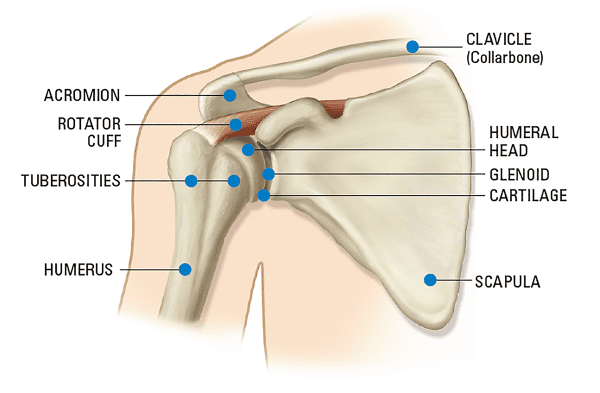The shoulder is the most flexible joint in the body that enables a wide range of movements including forwarding flexion, abduction, adduction, external rotation, internal rotation. Thus, the shoulder joint is considered the most insecure joint of the body, but the support of ligaments, muscles, and tendons function to provide the required stability.

The shoulder joint is a ball and socket joint made up of three bones, namely the humerus, scapula, and clavicle.
The end of the humerus or upper arm bone forms the ball of the shoulder joint. An irregular shallow cavity in the scapula called the glenoid cavity forms the socket for the head of the humerus to fit in. The two bones together form the glenohumeral joint, which is the main joint of the shoulder.
The scapula is a flat triangular-shaped bone that forms the shoulder blade. It serves as the site of attachment for most of the muscles that provide movement and stability to the joint. The scapula has four bony processes – acromion, spine, coracoid, and glenoid cavity. The acromion and coracoid process serve as places for attachment of the ligaments and tendons.
The clavicle bone or collarbone is an S-shaped bone that connects the scapula to the sternum or breastbone. It forms two joints: the acromioclavicular joint, where it articulates with the acromion process of the scapula and
Ligaments are thick strands of fibers that connect one bone to another. The ligaments of the shoulder joint include:
The rotator cuff is the main group of muscles in the shoulder joint and is comprised of 4 muscles. The rotator cuff forms a sleeve around the humeral head and glenoid cavity, providing additional stability to the shoulder joint while enabling a wide range of mobility.
Tendons are strong tissues that join muscle to bone allowing the muscle to control the movement of the bone or joint. Two important groups of tendons in the shoulder joint are the biceps tendons and rotator cuff tendons.
Bicep tendons are the two tendons that join the bicep muscle of the upper arm to the shoulder. They are referred to as the long head and short head of the bicep.
Rotator cuff tendons are a group of four tendons that join the head of the humerus to the deeper muscles of the rotator cuff. These tendons provide more stability and mobility to the shoulder joint.
Feel Free to Reach: Orthopedic Surgeon in Bangalore
Traumatic injury to the shoulder or overuse of the shoulder (throwing, weightlifting) may cause the labrum to tear.
Osteoarthritis is also called a degenerative joint disease; this is the most common type of arthritis,which occurs often in the elderly.
Rotator cuff is the group of tendons in the shoulder joint providing support and enabling wider range of motion…..
There are many causes of shoulder pain. It depends on the age of the patient and the associated medical comorbidities. The most common cause in most of the diabetics is Frozen Shoulder ( Periarthritis shoulder).
Rotator cuff tear, Impingement Syndrome is also the most common cause of shoulder pain.
Repeated overhead activities can cause shoulder pain. Biceps tendinitis, SLAP lesions are common causes.
The main treatment of it is the Range of movement exercises and to apply cold packs after that. In severe cases with restriction of movement- Arthroscopic Capsular release is done. Manipulation under anesthesia is also done for this.
The main investigation of choice is MRI.
It depends on the type of tear and other associated shoulder pathologies like subacromial bursitis and hooked acromion which itself can cause a tear.
Arthroscopic Rotator cuff repair using suture anchors which are absorbable.
The shoulder is immobilized in arm sling after surgery for a period of four weeks. Passive shoulder mobilization is started on the first post-op day. You will be able to work on your laptop from the very first post-op day. But lifting weights is avoided for a minimum period of three months.
These are commonly seen in repeated Shoulder dislocation. Bankart lesion is over the glenoid bone and Hillsach’s lesion is over the numeral head.
Yes, you do require Arthroscopic Bankart repair where the torn labrum is stitched back which prevents further dislocation.
Latarjet surgery is done for a shoulder dislocation in which a bony block is fixed to your glenoid with screws.
The shoulder is immobilized in a sling for three to four weeks. Passive mobilization and strengthening exercises started gradually.
It depends entirely on the kind of injury you had and the rehabilitation after your surgery.It varies from patient to patient.